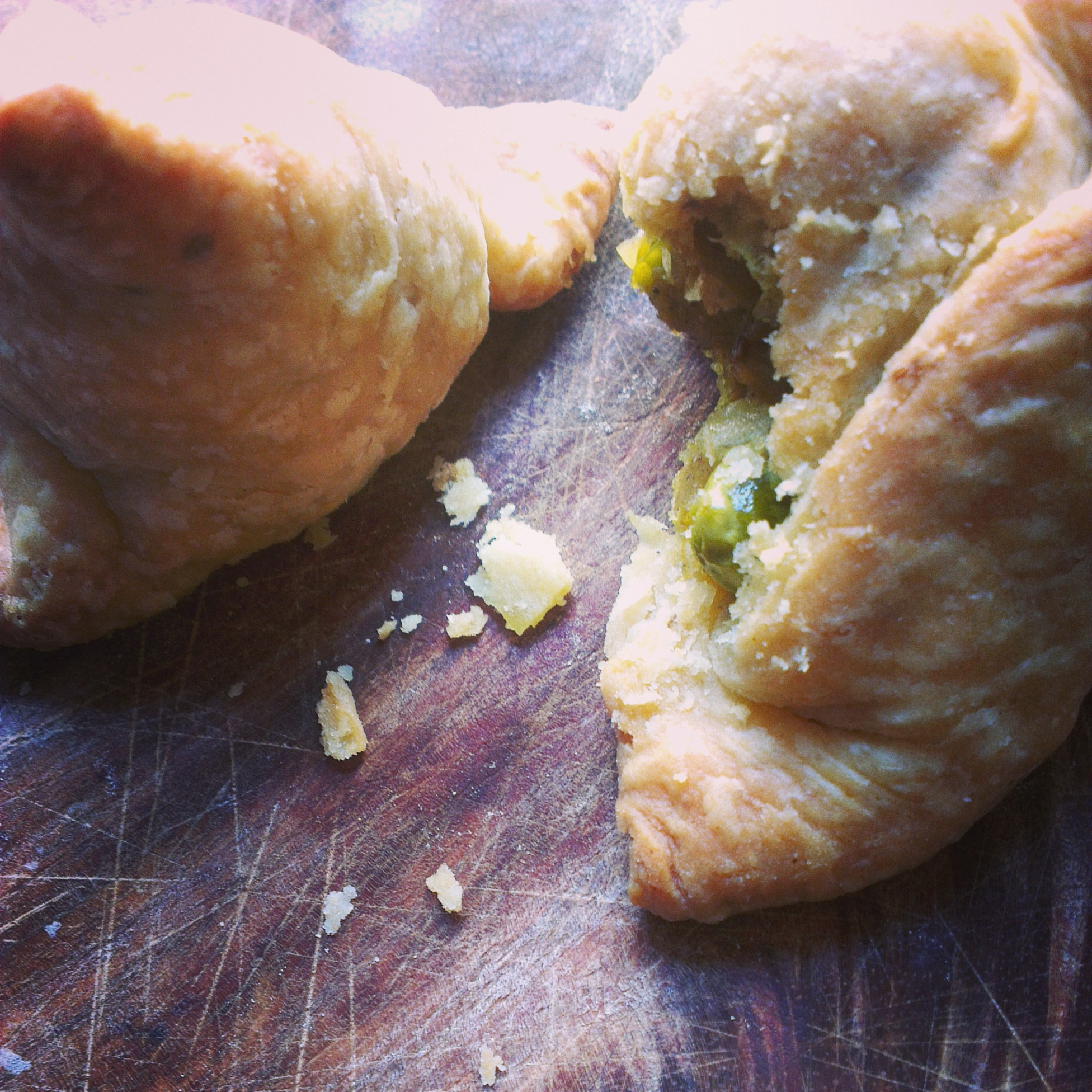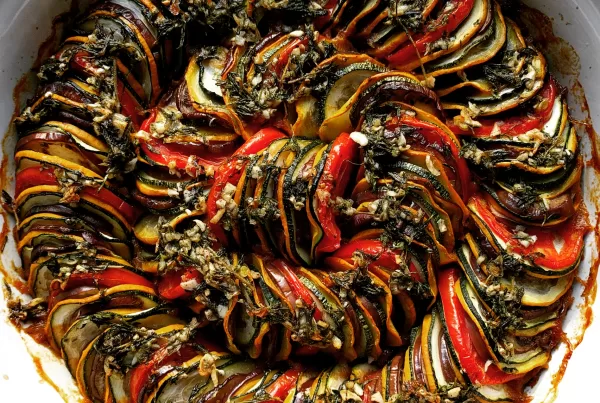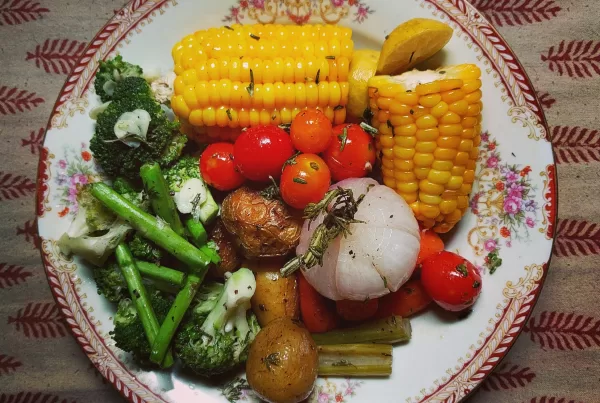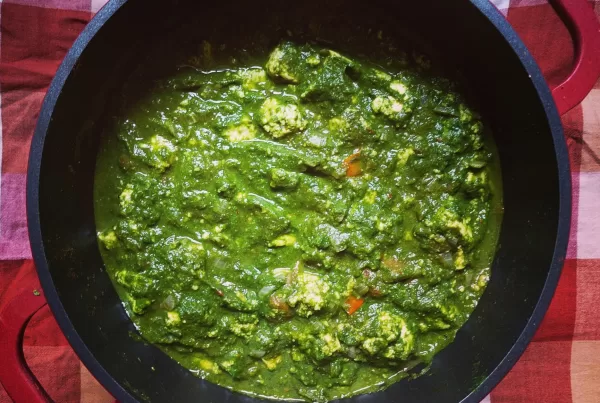I’ve been contemplating buying a deep fryer for the longest time, with a list of recipes to try out (samosas and super crisp French fries top this list). While I was researching samosas the other day I realised that one of the qualities that makes a samosa delicious is its explosively crunchy and super flaky crust, with the flavour of salt and ajwain within it.
Flaky crusts are a technique that I’ve now perfected thanks to all my pie and tart experiments, so it only seemed logical that I could use this flakiness to make samosas that didn’t require a deep fryer to make. . The basic principle of it is to cut butter into the flour in a way that leaves little chunks of butter the size of coarse sand or grit within the dough. These little chunks flatten out and layer up when the dough is rolled out, and once it is baked, gets absorbed into the flour, leaving little flaky voids while also flavouring and colouring the dough with buttery goodness.
The dough is a little delicate, and needs to be kept cold and handled quickly, but this is hardly as tedious a process as it sounds.
Another edit I made to the recipe was to use onions (the standard Punjabi version doesn’t use onions). The logic behind this is in the cooking of the spices. Usually, the spices are added directly to the hot ghee and cumin, after which the potatoes are added. If you add the potatoes too late, the spices might burn, and if you add it too early, the softness and bulk of the potatoes won’t let the spices cook.
The onions act as an intermediary body to cook the spices with, giving them enough time to fry and grow more flavourful by the time the peas and potatoes come in.
I’m quite happy to say that this whole baked samosa experiment was a success. While deep frying will always yield a crunchier crust (with that almost glassy crackle to the outer crusty bits), baked samosas feel lighter and flakier, and if I may be so bold, more flavourful, thanks to all that butter. Their trans-fat content might also be lower than deep fried samosas. That being said, I have to point out that though they might be relatively healthier than deep fried samosas, these aren’t some sort of diet samosas that’ll keep your arteries cholesterol-free. There’s a lot of butter contributing to all that sexy flakiness, so moderation is key.
The whole thing takes about two hours to prepare, with a moderate amount of skill required. Samosas are assumed to be something you’d rather buy than make at home, possibly because of the complexity of the deep frying process, especially since some samosas are double-fried for extra crunch. Baked samosas however, are much easier to prep. You could even assemble them and freeze, baking them off one by one (after bringing them down to room temperature of course) for about a week after you make them. make sure you wrap them in clingwrap to keep them from drying out in the fridge.
The Recipe
Ingredients
For the crust
105g Atta (whole wheat flour)
105g Maida (all purpose flour)
150g butter
½tsp salt
1tsp ajwain (carom seeds)
90ml ice cold water
For the filling
2 large potatoes
1 onion
1tbsp ghee/cooking oil
A pinch of asafoetida
1tsp cumin (whole)
2tsp coriander powder
1tsp garam masala powder
½tsp turmeric powder
40g (a handful) peas
1 large green chilli
Salt to taste
Yields ten medium-sized samosas.
Method
- Cut the butter into tiny cubes and freeze for about two hours or more.
- Mix the flours and salt in a large bowl.
- Add the butter to this in three parts and cut the butter into it using a pastry blender, food processor or by rubbing it into the flour with fingers (if you don’t have hot hands) till it reaches a coarse meal consistency
- Pour the ice cold water into this to bring the mixture together. Wrap in clingwrap and flatten into a disc. Let this rest in the fridge for at least an hour.
- Cut the potatoes into quarters and boil or pressure cook them till cooked through. Peel and set aside.
- Chop the onions fine and slice the green chilli.
- Heat the ghee/oil in a pan and add the cumin to it. Wait till it starts to splutter.
- Add a pinch of asafoetida, followed by the onions. Cook till they turn translucent.
- Add the coriander powder, turmeric and garam masala.
- Once the masala is cooked, add the potatoes. Using your spatula or ladle, cut the pieces of potato into smaller bits while stirring. You don’t have to mash the potatoes in; lumpy is good.
- Add the peas and cook until the peas are done. Let this cool to room temperature.
Assembly
- Divide the pastry dough into five equal parts and roll them into balls with your hands.
- Roll each ball out into a disc, about 2mm thin, and longer along one axis (more of an oval than a circle).
- Cut the oval along its minor axis (along its width) into two halves.
- Brush some water along the inner edge of the half oval, using a pastry brush or fingertips.
- Form the half oval into a cone, by bringing the straight edge over itself. Pinch the pointy end to seal it.
- Divide the potato masala into ten equal parts. Spoon one part into the cone you’ve just made and seal the open part in a Y-shape.
- Freeze for about half an hour, while the oven pre-heats to 180ºC.
- Bake for 20 minutes, and then flip them over to let the bottoms also bake for an additional 20 minutes. Keep an eye on the pastry, it should turn a golden brown and shouldn’t overcook and become hard.









I loved this post. And these samosas need to be made!
It worked really well – I reduced the butter to 100 grams and the crust was still flakey enough. I am making a huge batch to freeze – hope it works when baked from frozen!
That’s great, I’m happy to hear they turned out well! Have you posted any pictures online to Instagram or elsewhere?
I can say this is the best baked samosa recipe out there just by looking at it!
I know the butter has its own significance in the recipe but is there any way we can substitute butter with vegetable oils? TIA!
I’m sure vegetable shortening would actually yield a super flaky crust. The variety we get here is super hydrogenated and full of trans fats, so I’ve never actually tried. There’s also another variety that splits the dough in two, puts oil in one and then kneads them together in layers, and the layering makes for much flakiness. The simplest way would be to use vegetable shortening.